

Marketplace on Stitcher - 3D printing could be the future of construction. Will 3D Printing Upend Fashion Like Napster Crippled the Music Industry? Before MakerBot, no one could have conceived of Napster for fashion.

A Burberry trench couldn't be replicated digitally, which meant the garment industry was more or less safe from the revolution that upended music production and book publishing. But with 3D printing, Fifth Avenue is headed for its own disruptive moment. 3D printers can manufacture spare parts for spacecraft, produce food and housing, even replicate human organs. Simultaneously, the materials used in 3D printers are improving by leaps and bounds, incorporating metals and plastics, wood and nylon. World's first 3D-printed titanium bicycle frame could lead to cheaper, lighter bikes. The MX-6 Evo mountain bike, sporting its 3D-printed titanium frame Image Gallery (3 images) When it comes to a high strength-to-weight ratio, titanium is just about the best material out there for manufacturing bicycle frames.
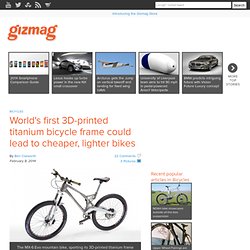
Unfortunately, those frames are also quite expensive. They could be about to come down in price, however – two British companies recently teamed up to create the world's first 3D-printed titanium bike frame. Renishaw, an additive manufacturing firm, joined forces with Empire Cycles to build the one-off titanium MX-6 Evo mountain bike. The frame was built using an AM250 laser melting machine manufactured by Renishaw. Because titanium has a higher density than aluminum, less of it had to be used if Empire wanted a finished bike that was lighter than the stock model. As a result, at a total of 1,400 grams (3 lb), the finished Evo frame weighs 33 percent less than its aluminum counterpart. So, how could this project lead to cheaper titanium frames? Meet The 17-Year-Old Who Created A Brain-Powered Prosthetic Arm. Easton LaChappelle’s story offers a reminder of the simplest key to success--if you want something badly enough, do the work and find creative ways to achieve your desired outcome.
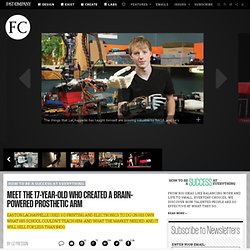
If traditional systems aren’t providing what you need to accomplish your mission, then break away--break away from your 9-5 job, break away from the agenda that’s set by conventional mind-sets. Easton broke away from the limitations of the public education system and taught himself what he wanted to know. For LaChappelle, this meant learning how to build a better prosthetic arm. “I tested a need in the market with a Kickstarter campaign. The need was there, so now I’m working to fill it. LaChappelle’s mission is to reinvent conventional prostheses. 9 Ways 3-D Printing Makes The World Better. You’ve heard it before: 2011 2012 2013 is the year of 3-D printing.
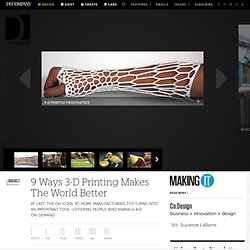
The future is here! The individual will wrench manufacturing power from the global industrial complex! The Most Incredible 3-D Printed Things We’ve Ever Seen ⚙ Co. The levees have broken for 3-D printing, and the resulting deluge of printing-concepts-on-the-cheap is flowing faster than we can gather.

The best of these rise to the surface for their innovating predictions of a faster/safer/healthier future. A Robotic Hand That Doesn’t Cost An Arm And A Leg Teen engineer Easton LaChappelle created his first robotic hand out of Legos, fishing wire, and surgical tubing--a feat that earned him 3rd place at the Colorado Science Fair. More importantly, it introduced him to a young girl who was born without an arm and needs new prostheses as she grows, which cost a hefty $80,000 per arm. Sensing an opportunity, LaChappelle taught himself 3-D printing and created a dextrous arm controlled by an Arduino chip.
Speaking at TEDxMileHigh last month, LaChappelle presented the arm, which features as much motion and almost as much strength as a human arm and costs just $400. [Image credit: TEDxMileHigh] Cortex 3D-printed cast for fractured bones by Jake Evill. 3D-printed casts for fractured bones could replace the usual bulky, itchy and smelly plaster or fibreglass ones in this conceptual project by Victoria University of Wellington graduate Jake Evill.

The prototype Cortex cast is lightweight, ventilated, washable and thin enough to fit under a shirt sleeve. A patient would have the bones x-rayed and the outside of the limb 3D-scanned. Computer software would then determine the optimum bespoke shape, with denser support focussed around the fracture itself. The polyamide pieces would be printed on-site and clip into place with fastenings that can't be undone until the healing process is complete, when they would be taken off with tools at the hospital as normal. Unlike current casts, the materials could then be recycled. "At the moment, 3D printing of the cast takes around three hours whereas a plaster cast is three to nine minutes, but requires 24-72 hours to be fully set," says the designer.
Here's some more information from Evill: Christopher Cordingley — on to something new! Road-ready 3D-printed car on the way. News: a fuel-efficient 3D-printed car is set to hit the road in two years, according to its US-based manufacturer RedEye On Demand.
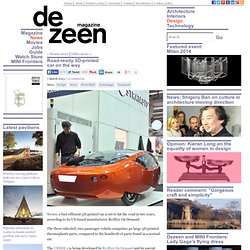
The three-wheeled, two-passenger vehicle comprises 40 large 3D-printed thermoplastic parts, compared to the hundreds of parts found in a normal car. The URBEE 2 is being developed by RedEye On Demand and its parent company, 3D printer maker Stratasys, in collaboration with KOR EcoLogic. So far in its development, 3D printing has largely been used to produce unique or customisable items in single editions or small runs, but the arrival of the URBEE 2 suggests it could also be applied to mass production on a huge scale.
"A future where 3D printers build cars may not be far off after all," said Jim Bartel, vice president of RedEye On Demand. "URBEE 2 shows the manufacturing world that anything really is possible. Once it's road-ready, the designers plan to drive URBEE 2 from San Francisco to New York on just 45 litres (10 gallons) of biofuel such as ethanol. MIT's New Self-Assembly Lab Is Building A Paradigm Shift To 4-D Manufacturing. Sitting on a table in Skylar Tibbits’s lab, at MIT’s new Center for International Design, is a 200-gallon-fish tank--it's large enough to hold one of Damien Hirst’s pickled sharks.
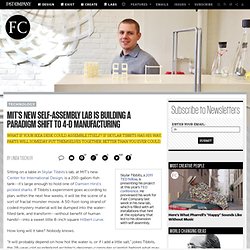
If Tibbits’s experiment goes according to plan, within the next few weeks, it will be the scene of a sort of fractal monster movie. A 50-foot-long strand of coded mystery material will be dumped into the water-filled tank, and transform--without benefit of human hands! --into a sweet little 8-inch square Hilbert curve. How long will it take? Nobody knows.